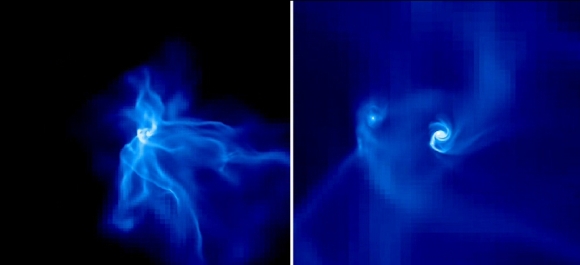So how do rare massive stars grow 10 to 150 times the mass of our Sun? It turns out that a standard star-forming nebula is way too cold for big stars to form. So how can these clouds of gas and dust be prepared so massive stars can develop? Answer: Let small stars do the hard work and heat that nebula up…
This is the ultimate stellar crèche. Star-forming nebulae are vast regions of space filled with gas and dust. Proto-stars need a lot of hydrogen to form and begin fusion reactions in their young cores. The bigger the nebula, the bigger the star… or so you’d think.
The problem with these young nebulae is that they are cold; in fact they are very cold. Typical interstellar clouds of hydrogen have temperatures very close to absolute zero (the lowest temperature possible) due to the lack of heat in the far-off reaches of the cosmos. Cold clouds will fragment very easily, breaking up and forming smaller clouds of hydrogen. Eventually they will collapse to form stars, but these stars will be very small due to the lack of fuel in the nebula fragment. If this is the case, how are massive stars – the ones responsible for producing heavy elements including anything heavier than helium – formed at all? Surely all clouds of dust and gas are cold, and therefore fragment, only producing small stars?
From research published in Nature this weekby Christopher F. McKee (a professor from UC Berkeley) and Mark R. Krumholz (Hubble postdoctoral fellow at Princeton), there is a possible solution to this problem. Perhaps young stars provide a heating source to warm up the surrounding nebula, preventing the surrounding gas from fragmenting, allowing it to collapse into progressively bigger stars.
Starting at temperatures only 10-20 degrees above absolute zero, clouds heated by young stars may increase in temperatures three-fold. However, researchers realize that a massive star-forming cloud needs to be several hundred degrees warmer than absolute zero to prevent the whole cloud from fragmenting, they also understand that the “zone of heating” for each small star is limited in less dense clouds. This situation changes when the star-forming cloud is dense. The zone of influence each small star has will encompass the whole nebula. This collaborative heating effect by the small stars prevents fragmentation and allows larger volumes of gas to collapse, forming massive stars.
“It’s only the formation of these low-mass stars that heats up the cloud enough to cut off the fragmentation. It is as if the cold molecular cloud starts on the process of making low-mass stars but then, because of heating, that fragmentation is stopped and the rest of the gas goes into one large star.” – Christopher F. McKee.
A warmer cloud is a bigger cloud, providing more fuel, allowing massive stars to form. It is the ultimate stellar nursery; massive stars can only form once their smaller (and older) siblings warm up the cosmic nest for them to thrive.
View the stunning simulation of a massive star forming in a warm cloud (24Mb, .mpg)
Source: UC Berkley News


Stupid question, is it possible for super-massive black holes to build up from a birth in an exceptionally large nebula that was no where near a galactic core (sorry this article triggered a though coming from the preceding article).
Does this mean that there is a possibility of a larger star being formed eventually in something like the Orion’s trapezium?? Or would it be most likely only in a thicker, less visible area of a nebula?
The subject: the birth of stars and galaxies: is riveting. All observations, simulations, experiments (how does one do them?), and thoughts are important and welcome.
Oh the extremes! From the remains of the BigBang to the gas fields where galaxies and stars are forming is as extreme as possible.
‘Expect the unexpectable’ seems to be sensible. Are there always vast discs of gas and dust with small balls of fire and stars in them?
Gravity combines, yet energy expands and defies gravity. Is energy anti-gravity and gravity the end of energy?